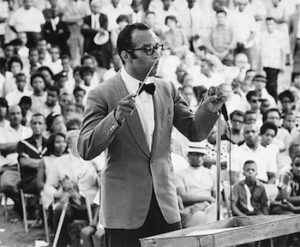
Henry Lewis
Henry Lewis was born on this date in 1932. He was a Black double-bass player and orchestra conductor.
Lewis was born in Los Angeles. At the age of five, he began studying piano. He later learned to play the clarinet and several string instruments. At 16, he joined the Los Angeles Philharmonic, becoming the first Black instrumentalist in a major orchestra. After six years as a double bassist with the Los Angeles Philharmonic Orchestra, he played with and conducted the Seventh Army Symphony while serving in the United States Armed Forces (1955-1956).
He gained national recognition in 1961 when he was appointed assistant conductor of the Los Angeles Philharmonic under Zubin Mehta, a post he held until 1965. Lewis moved to Newark, NJ, wherein, in 1968, he became conductor and music director of the New Jersey Symphony, a small community ensemble.
He transformed the ensemble into a nationally recognized orchestra that performed over a hundred concerts yearly, including outreach programs for local communities. In 1972, he debuted at the New York Metropolitan Opera, conducting Puccini's La Boheme. From 1960 to 1979, he married famed opera singer Marilyn Horne, who considered him her "teacher and right hand.”
After retiring from the New Jersey Symphony in 1976, Lewis continued to tour as a guest conductor for 20 years. He was the first Black person to become a regular conductor of a major American symphony orchestra. During a musical career that spanned nearly five decades, Henry Lewis gained wide respect as a conductor, instrumentalist, and pioneer in classical music. Lewis died from a heart attack in 1996 at the age of 63.